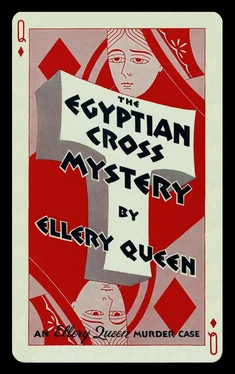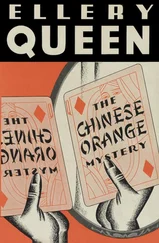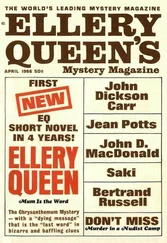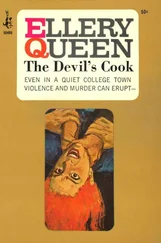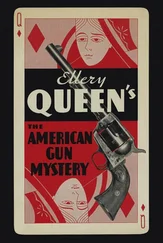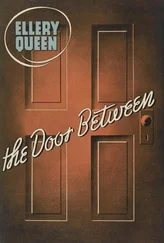“But when, at the investigation of the fourth murder, I knew Andreja Tvar to be deus ex machina, the whole motif was plain. In his first murder — the killing of Krosac — he was forced to decapitate Krosac to prevent identification of the body and to permit an acceptance of the initial idea that the body was Van’s, and the subsequent idea that the same body was Kling’s. Yet merely to sever the heads would have been to invite suspicion and disaster; any investigator would have swung into the right track. So Van manufactured the brilliant and objectively irrational conception of maniac-conceived T’s — T shapes of every description and with no possible interrelationship. These so confused the main issue that he was sure no one would grasp the real significance of the missing heads; which was, of course, to permit false identifications of the first and last bodies.
“Once started, naturally, he was forced to continue the vagaries of the nightmarish T’s. He had to cut off Brad’s head and Megara’s head to maintain the continuity of a Krosac-T-phobia interpretation. At the last murder, of course, the head-severing served a genuine purpose again. It was a damnably clever plot, both psychologically and in execution.”
“About the last murder,” said Isham, swallowing. “Er — was it just my imagination, or was the set of footprints leading into the hut deeper than the set coming out?”
“Excellent, Mr. Isham!” cried Ellery. “I’m glad you brought that up — a good point. It served as a prime confirmation of the entire recapitulation of the case. I noticed, as you say, that the murderer’s footprints approaching the shack were deeper than those departing from it. Explanation? A simple enough syllogism in logic. [3] Purchasers of Mr Ellery Queen’s The Greek Coffin Mystery will recall that in its pages was included a little pamphlet entitled How to Read the Queen Stores. In this pamphlet Mr. Queen outlined the identical syllogism which appears above — a little jest of his own which his readers could not have been expected to appreciate fully, since they had no way of knowing that this exercise in logic would be an integral part of the succeeding novel. - The Editor.
Why should the identical footprints in the identical earth be heavier in one case than the other? Because in one case the murderer was carrying something heavy; in the other he was not — the only argument which will logically explain the strange difference in weight of the same individual in approximately the same period. This fitted admirably. I knew that Kling’s was the last body found. Where had Van kept Kling? Not in the hut; then it must have been somewhere in the vicinity. Constable Luden once said that the hills in West Virginia are riddled with natural caves; Van himself at one point said that he had found the abandoned hut while he was on a little cave-exploring expedition! (Probably with this very thought in mind!) So Van went to the cave where he had kept Kling a prisoner for long months, got Kling, and carried him into the hut. The rain must have stopped after Van left the hut to get Kling, but before he returned carrying Kling; it wiped out his outgoing footprints, but took the impression of his returning footprints. So the deep prints were made when he lugged Kling into the shack; and the shallower ones when he left the hut after the murder, for the last time.”
“Why didn’t he make Kling walk into the hut?” demanded Isham.
“Obviously because he intended from the first to leave a trail to a limping man, Krosac. By carrying Kling and limping he achieved the double end of getting the victim into the house and also making it appear that one man — Krosac — had entered. By limping away he clinched the illusion of Krosac’s escape. He made only one mistake: he forgot that, weighted down, the impressions in soft earth would be deeper.”
“I can’t get it through my thick skull,” muttered the Professor. “The man must have been — must be — a genius. Perverted, and all that; but that plot of his required a brilliant brain.”
“Why not?” asked Ellery dryly. “An educated man, with years in which to plan. But brilliant nevertheless. For example: Van was faced throughout with this problem: he had to arrange matters so that there was always a legitimate reason for Krosac to have done the very things that he himself, Van, had to do. That business of the pipe, for instance, and the turned-about rug with the bloodstain on it, and the deliberate leaving of Brad’s note. I’ve already related to you Krosac’s reason for wanting a delay in the discovery of the real scene of the crime — which was to have it discovered only when Megara arrived on the scene, so that Megara could seemingly lead Krosac to Van, who from the note Krosac supposedly learned was still alive.
“But Van, while he provided us with this ingenious Krosac reason, as the real murderer had even better reasons for causing the delay. If the police searched the library at once they would have found Brad’s note — undoubtedly suggested to Brad by Van himself — long before Megara’s return. They would know at once, then, that Van was still alive. If any slip-ups in Van’s activities caused the police to suspect that Old Pete was Van, then Van’s position became precarious. Suppose Megara never returned, died on shipboard somewhere. Then there would be no one left alive to confirm for the police the fact that Old Pete, or Van, was actually a brother of Brad and Megara. By causing the delay he insured a confirmation of his brotherhood at precisely the time Megara returned. On his unsupported word he might come under suspicion; with Megara to corroborate every statement he made, he looked like an innocent man.
“But why should he want to reappear on the scene at all? Ah, but here we see the real end achieved by his complicated arrangement of a delay until Megara returned. By contriving beforehand that Brad leave the note that instituted the whole chain of events which ended with the return to the scene of Andrew Van as an accredited brother of the Tvars, Van clinched his inheritance. By that I mean: Van could have made the police believe he actually had been murdered in the first crime, and could have remained legally dead thereafter, while he continued his plot of killing his brothers from the dark of the Krosac guise. But if he had remained legally dead, how was he to collect the money which Brad was leaving him by will? So he had to come back — alive. And at a time when Megara could confirm the fact that Van was a brother. In this way he collected the five thousand dollars due him with perfect safety. Incidentally, his constraint was commendable. Do you recall that Megara, touched by his ‘frightened’ brother’s plight and his own conscience, actually offered Van an additional five thousand — and Van refused? He wanted only what was coming to him, he said... Yes, a clever rogue. He knew that refusal would cement the illusion of the eremetic character he had so carefully built up.
“And finally, by means of the note and the story he told on his return to the scene, he prepared the police for an acceptance of his own second murder, since now they knew that a vendettist was on the trail of the Tvars and had discovered that he had made a mistake in the first murder. Devilish, really.”
“Too deep for me,” said Vaughn, shaking his head.
“That’s what I’ve been up against ever since I became a father,” murmured Inspector Queen. He sighed, and looked happily out of a window.
But Professor Yardley had no paternity to feed his ego, and he did not look even remotely happy. He was pulling at his short beard with powerful if abstracted fingers. “Granted all that,” he said. “I’m an old hand at puzzles — chiefly ancient, I confess — so another example of man’s ingenuity doesn’t precisely amaze me. But one thing does... You say Andreja Tvar, blood-brother to Stefan and Tomislav Tvar, partner in their family and personal iniquities, planned for years the extermination of these same brothers. Why? In the name of a merciless God, why?”
Читать дальше
